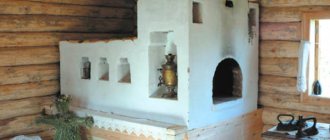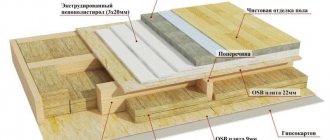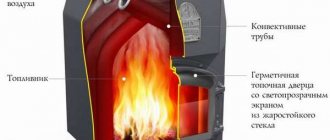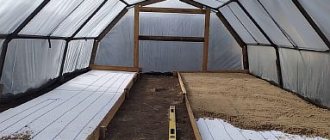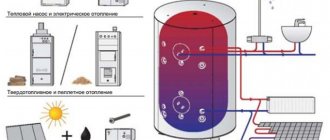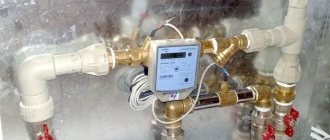Modern design does not ignore attic and attic spaces and considers them valuable living space. Very often, an empty room under the roof is converted into bedrooms, a study, a children's room, or used as a billiard room. It is the low ceiling, under the slope of the roof, that allows you to create a cozy atmosphere for relaxation.
Roof insulation scheme.
However, in order for this additional area to become a residential part at any time of the year, you need to take care of its heating. It is no secret that heating an attic is a rather complex technical task, which first of all begins with the process of thermal insulation of the roof. It is this kind of work that will allow you to retain heat and use the room for year-round use.
Attic heating
Attic is an attic-type room in residential buildings. Installation of utilities and heating of the attic are necessary conditions for comfortable use of the room as a bedroom, playroom, nursery, office. The attic heating system solves a number of problems:
- maintains a stable positive temperature during the cold season;
- does not allow the room to freeze;
- prevents the formation of ice and a decrease in the performance characteristics of building and finishing materials.
Properly designed attic heating in a house consumes a minimal amount of energy, does not increase energy consumption during the heating season, allows you to regulate the temperature in the room and is responsible for a healthy microclimate.
Attic heating: modern methods
There are several ways to heat the attic in a bathhouse and a country house. The first of them is connection to the common boiler room of the cottage. A pipeline is laid in the attic, radiators are installed through which the coolant circulates - water heated in the boiler room. When choosing the optimal method for heating the room, it is recommended to take into account the following disadvantages of a water heating system for the attic:
- The load on the boiler increases: if it was not originally designed to heat the attic, then the temperature in other rooms will drop and fuel consumption will increase.
- The attic is removed from the boiler: the coolant reaches the attic at a lower temperature, having already given off heat to other rooms. This reduces the efficiency of heating the attic, or leads to the need to install a large number of radiators.
The second method is “warm floor”. A heating cable is laid under the floor covering over the entire floor area, connected to the electrical network. The temperature is regulated using controllers; it is possible to program the operation of the attic heating system: it will automatically turn on at the desired hours, or when the temperature drops to a set minimum. But “warm floors” have their drawbacks. Their installation requires serious time and financial investment: you will have to completely re-lay the floors and select fireproof materials with a high heat transfer coefficient, for example, natural stone. To operate, you need a constant connection to the power grid; a lot of electricity is consumed; during the heating season, bills from energy sales companies rise sharply. This is an expensive solution, difficult to implement and maintain. Therefore, the owners of country cottages recognize that an economical way to heat the attic is an autonomous system . The principle of operation of air heating of an attic in a house is as follows: the heater heats the air entering it and forces it into the room using a fan. Heated air masses circulate, evenly transferring heat to the floor and walls. A positive temperature quickly sets in the attic. Additionally, excess moisture that rises from throughout the house and accumulates in the attic is removed from the air. Building materials are not at risk of becoming damp or freezing when the temperature drops sharply. The service life of roof insulation increases. To prevent air heating from creating a load on the electrical grid, devices powered by solar energy are selected.
Benefits of using solar energy for attic heating
- Autonomy.
Heating equipment powered by solar energy does not require connection to the electrical network or the use of other fuel. - Easy to install.
The products are installed on walls or on the roof. Installation is simple and fast; no complex design documentation is required. - Effective work.
The devices maintain a positive attic temperature throughout the autumn-winter period.
Attic heating using solar energy is used in residential buildings in the USA, Canada, Russia, Europe and the CIS.
Insulation of heating pipes in the basement Pipes and plumbing
House heating costs are increasing every year. Each owner is looking for ways to save: the boiler turns on periodically, or constantly works only at a minimum, and so on. The use of such methods leads to a significant decrease in the temperature in the house. But few people think about how efficiently the living area is heated, because most of the heat is lost on the way to it.
If heat loss can be minimized, then the rooms will warm up better and faster; therefore, continuous operation of the boiler will not be required, and it will be possible to resort to savings without compromising the temperature. Since boilers are often located in basements and other utility rooms, we will consider how to insulate heating pipes in the basement and other possible places where the system passes.
Heating a private house with an attic
Adding another level to the house or converting the attic space are the most common options for solving the housing problem in a limited area. Creating a favorable microclimate in the attic in the technical aspect is a rather difficult task. The main reason is that the additional “squares” are under the roof. It is through it that increased heat exchange occurs, since hot air, according to a well-known law, tends upward. And this part of the building is ventilated more intensively. This determines the specifics of attic heating. What heating technologies exist?
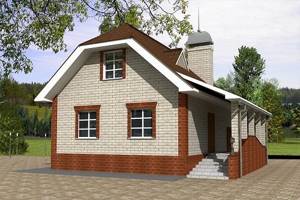
Insulation
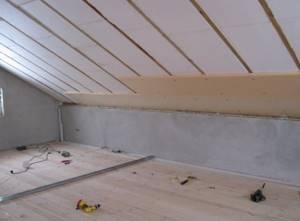
One of the simplest and relatively cheap methods. The thermal insulation layer is installed from the inside, and polystyrene foam boards are most often used as the material . Their fastening has its own peculiarity due to the rigidity of the samples. The natural shrinkage of wood must be taken into account. In relation to the attic, this mainly applies to the rafter legs. To avoid further deformation of the heat-insulating layer, the plates are fastened with a gap of about 5 mm. The joints between them are sealed with polyurethane foam - the most convenient and effective method.
Judging by the correspondence on relevant forums, then with high-quality insulation of the attic, additional heating may not be needed at all. Except for heating in severe frosts. And that’s not a fact.
With this method of insulation, it is advisable to regulate the humidity in the attic. When its value is increased, fungus and mold develop on polystyrene foam, which will gradually spread to the lining of the walls and ceiling.
Mineral wool for attic insulation is used less frequently. The main reason is the need to ensure high-quality waterproofing of surfaces, since all types of products in this group are hygroscopic. That is, they absorb liquids.
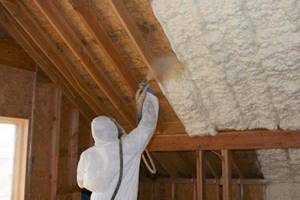
Polyurethane foam . This is spray-on insulation. Its effectiveness, with a competent approach, is maximum. The difficulty is that you need to purchase the appropriate equipment or invite specialists with your own. And these are additional costs. There is another negative point - low maintainability. While it is quite easy to replace slabs (mats), it is much more difficult to replace polyurethane, which adheres tightly to the base (glued).
What to consider . One of the most difficult issues is choosing the optimal insulation thickness. Firstly, this layer (plus the cladding) conceals the usable area of the attic. Secondly, few people take into account such a factor as the position of the dew point. Incorrect calculation of the parameters of the heat insulator can lead to moisture condensing in the room. The result is constant dampness in the attic with all the attendant “charms”.
Preparation
In any case, we will first need to properly insulate the attic, otherwise the cost of heating it will be very high. Since the floor is located in direct contact with the roof, it is necessary to carry out work on its thermal insulation.
Advice: pay special attention to the insulation of the attic; the better you do it, the more comfortable the living conditions in it will be, and the less money you will have to spend on additional heating.

High-quality heating is impossible without proper roof insulation
Selecting a heating system
If the house is just being built, it is necessary to provide heating for the attic floor at the design stage. However, as construction practice shows, most often the attic space is turned into an additional living area after all the work has been completed.
In this case, you cannot do without additional costs associated with wiring the necessary communications and choosing the optimal option for heating the room:
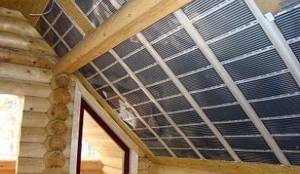
Do-it-yourself attic heating using infrared panels
What to pay attention to
Whatever you choose, you must first develop a heating system design, in which you try to take into account all the design features of the building, the need for materials, their cost and quantity.
The heating diagram for a cottage with an attic will allow you to understand:
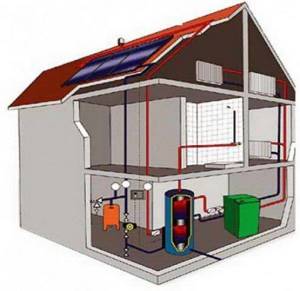
General heating scheme for a house with an attic
Don't hesitate to seek professional help to get a safe and effective system. Although, if you have certain abilities and the necessary materials, you can do the heating of the attic floor with your own hands.
| We connect to the general heating system of the house | When a heating system is already installed in the cottage, it may be necessary to install more powerful equipment to heat the attic. In this case, you will need a boiler, a pump, laying additional pipes and connecting radiators. If the house has strong floors and design features, the instructions allow for pipes to be laid under the flooring. If air heating is installed, an additional air duct system is required. |
| Autonomous heating method | A convenient, although quite expensive, heating method. It makes it possible to maintain a comfortable temperature on the floor at any time of the year. This method is usually used when heating the attic floor with a stove or when it is impossible to connect to a common system. It includes: The heating boiler should be selected depending on the availability and ease of use of certain types of fuel. Its power must correspond to the size of the room. You can calculate them yourself or get them from specialists. |
| "Warm floor" | An efficient and modern heating method. In this case, the heated air rises evenly from below over the entire floor area. The technologies used to create wooden floor coverings make it possible to conveniently use the system in a country house. Electric or water heating can be used. In the latter case, due to its large weight, it is usually used in buildings with concrete floors. |
Tip: the standard calculation of heating power is 1 kW per 10 m2. In this case, the ceiling height is assumed to be 2.5-2.7 m.
Stove or fireplace
An excellent option for a heat source in the attic, which can also become an interior decoration. The main question that remains to be resolved before installing the fireplace is whether the ceilings will withstand it, since the structure has significant weight. It may be necessary to carry out work to strengthen them.
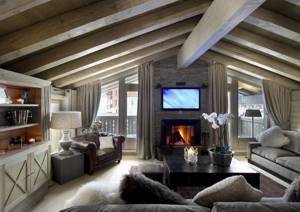
Using a fireplace as a heat source
Tip: the load can be reduced by using metal pipes and lightweight refractory bricks.
You can also purchase ready-made structures made of cast iron or steel. Such fireplace stoves are capable of creating a comfortable temperature in a room up to 200 m2.
Tip: to reduce the risk of fire, install structures at some distance from the walls or place them in the middle of the room.
Using an electric fireplace does not require much maintenance and is safer, although electricity will increase your heating costs. To reduce them, you can install convectors that will automatically turn off after reaching a certain temperature in the room.
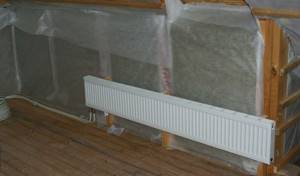
Installation of a steel water heating convector
Radiator installation
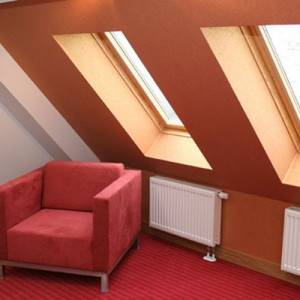
They are included in the general heating system of the house. In principle, there is nothing particularly complicated. But there are a number of nuances that you should be aware of.
- Is the boiler's power sufficient to prevent it from operating at maximum capacity with the additional load of an attic? Otherwise, the heating device will not last long. And replacing with a new unit is also not a pleasant prospect. Firstly, such equipment is expensive. Secondly, the question will arise of what to do with a used boiler.
- Most likely, you will need to install another pump or purchase a more powerful one. The same thing - what to do with the old one, which is in working order? And the problem with the pumping device will have to be solved, since the attic means not only an increase in the length of the route, but also an increase in the coolant to a height.
Types and characteristics
The material is obtained from molten blast furnace slag, stone (rocks) or glass. The structure of these fibers is thin, randomly arranged villi, ranging from 2 to 60 mm in length. This insulation is produced in the form of mats or slabs. In order for the fibers to better adhere to each other, the slabs are additionally impregnated with special oil (to repel moisture) and phenol alcohol.
Depending on the origin, they differ:
- Glass wool. It is made from a molten mixture of broken glass, sand, limestone, and soda. The fibers are 15-50 mm long and their thickness is 5-15 microns. The material is chemically resistant, difficult to ignite (withstands up to +500 o C).
Stone wool. To make it, gabbro-basalt rocks are melted. The thickness of the fibers is 4-12 microns, and their length is up to 16 mm. It heats up to 300 o C without igniting.
Installation of a small boiler in the attic
There are also such recommendations, so it’s worth figuring out how appropriate this is.
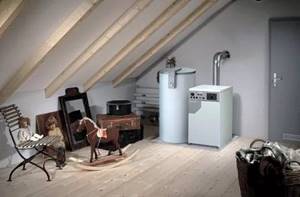
- Significant costs for heat generating equipment.
- Difficulties in choosing a place to install it.
- You will have to make passages in the roof (wall) to bring the pipe out.
- This solution is only possible with a concrete floor.
It is unlikely that this technique can be considered acceptable. Only as an exception. For example, if it is planned to install a communal boiler in the attic. By the way, the option with a fireplace for this room is not the best, unless we are talking about its electric counterpart. The main reason is the massiveness of such a heater.
Heated attic for year-round use
Modern design does not ignore attic and attic spaces and considers them valuable living space. Very often, an empty room under the roof is converted into bedrooms, a study, a children's room, or used as a billiard room. It is the low ceiling, under the slope of the roof, that allows you to create a cozy atmosphere for relaxation.
Roof insulation scheme.
However, in order for this additional area to become a residential part at any time of the year, you need to take care of its heating. It is no secret that heating an attic is a rather complex technical task, which first of all begins with the process of thermal insulation of the roof. It is this kind of work that will allow you to retain heat and use the room for year-round use.
Insulation
Styrofoam. The use of this material allows you to create excellent thermal insulation and save a lot of money. Attic insulation is usually carried out from the inside. Foam boards are laid together with a 5mm gap. The resulting cracks are filled with construction foam.
This technological process is designed for roof shrinkage, which occurs due to its own gravity, as a result of which slabs laid closely can begin to press against each other. Proper installation using polyurethane foam provides a complete guarantee of the absence of cold bridges. However, there are also negative aspects of using polystyrene foam: it is easily susceptible to mold and other fungi, so use in climates with high humidity is not recommended.

Comparative characteristics of roof insulation.
Minvata. A distinctive feature of this material is its low thermal conductivity, high fire-resistant properties, moisture resistance and good sound insulation. The insulation technology is almost the same as with polystyrene foam boards. However, there is a small nuance. To improve the moisture resistance of mineral wool, do not neglect additional insulating layers.
Polyurethane foam. Insulation, which is very similar to polyurethane foam and, after application, has the same properties as mineral wool. In addition, having high vapor barrier and water resistance, it does not need additional layers. For application you will need a special sprayer, thick clothing that covers all parts of the body and a mask. The process does not take much time (500 m² per day), which allows you to quickly insulate the attic.
Insulation of a cold attic with mineral wool
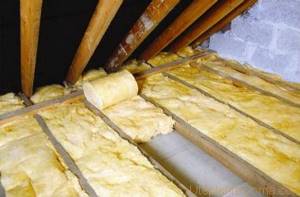
A vapor barrier is placed under the mineral wool.
To insulate the ceiling of a cold attic with mineral wool, you can take material of any density, from low to high. At the same time, it is still preferable to choose lighter materials so as not to create additional loads on the beams. Some experts are inclined to believe that glass wool is better suited for insulating an attic with mineral wool than stone wool. The latter is too brittle, and it weighs a lot. Also read: “Which insulation to choose for walls and ceilings.”
As you already understand, insulation of a cold attic of a private house with mineral wool is carried out by laying thermal insulation between the load-bearing beams directly on the rough ceiling of the first floor. Due to the high hygroscopicity of mineral wool, it is necessary to use a vapor barrier film. In principle, even simple polyethylene can be used. There will be no special loads on the film and if installed carefully it will not tear. To be completely confident in the reliability of the protective layer, you need to use a polypropylene vapor barrier reinforced with fiberglass mesh.
Insulating the attic with mineral wool, technology:
- the supporting beams are sewn up from below - this is the rough ceiling of the first floor;
- on the attic side, a vapor barrier is laid on the rough covering;
- Mineral wool is placed on top of the film.
Vapor barrier tapes should be laid overlapping, the joints should be taped with double-sided tape. The mineral wool is placed outward so that there are no cold bridges at the junction of the insulation with the beams.
Insulating a cold attic with mineral wool is always preceded by calculating the thickness of the thermal insulation. In any case, the layer will be at least 10 cm. Mineral wool is available in a thickness of 5 cm. It is better to lay thermal insulation in two layers with offset joints. This will eliminate the possibility of heat loss through the joints of the mineral wool sheets.
After insulating the attic floor with mineral wool, you can immediately lay the floor on top of the beams. It is advisable to first cover the insulation with waterproofing - a material that does not allow water to pass through, but allows steam to pass through, but only in one direction
It is important not to confuse which side to lay the waterproofing on, otherwise moisture will accumulate in the mineral wool, as a result of which the thermal conductivity of the material will increase significantly
It is quite possible to use a fireplace to heat a country house. To do this, a heat exchanger is built above the firebox.
Read about how to choose the sizes of brackets for radiators here.
Heating
Heating of the attic is envisaged at the initial stages of design and there are several ways:
- Connection to an existing heating system.
- Installation of an autonomous heating system.
- Fireplace.
- Warm floors system.
Connection to the heating system
In this case, connection to an existing heating system involves further laying additional pipes and radiators. It may be necessary to replace the equipment with more powerful models. This applies to the pump and boiler. With an air supply, you can connect the air ducts to the main line and lead them to the attic, which will allow you to have part of a well-heated room.
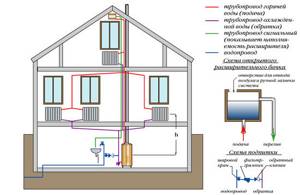
Heating diagram for a private house.
Autonomous heat supply system
Modern systems with autonomous heat supply allow you to maintain the required temperature in a heated room all year round. The main elements of this system:
- boiler;
- removal of waste products;
- air supply system;
- pipelines;
- pump;
- radiators.
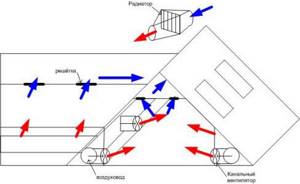
Scheme of air heating of the attic.
The main equipment in an autonomous heating system is a boiler, which can be gas, electric, liquid fuel, solid fuel or combined. Before installing all the elements, at the initial design stage, the location for the boiler and the fuel on which it will produce heat, as well as the path for the removal of combustion products, are first determined.
A very important point in the design of the system will be the choice of circulation, which can be natural or forced. Natural (gravitational) circulation allows you to do without a pump and will not depend on electricity . However, the large diameter of the pipe, the mandatory observance of slopes, and some restrictions in control are its main disadvantages. It is usually recommended to use a forced circulation method.
It is necessary to correctly calculate the boiler power for the heated room, which is usually the responsibility of a specialist. But you can do this yourself, since complex calculations are not required: 1 kW of boiler equipment power heats about 10 m² of a well-insulated attic, with a room height of up to 3 m. Thus, the required boiler is selected without excess power, which will significantly save the cost of its exploitation.
Warm floor system
The most comfortable temperature conditions for a person are a small difference, about 2-3º C, between the top and bottom of the room, which can be achieved by heating the floor. As a rule, such a system is used under stone or tiles, however, thanks to modern technologies, it is also acceptable in combination with wooden floor coverings.
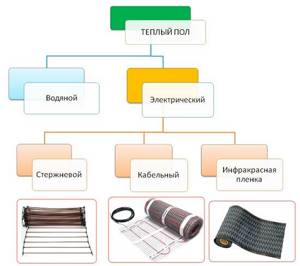
Classification of heated floors.
"Warm floor" using electricity. This system can be the only source of heat in the room, without using traditional radiators. There is a possibility of installation on any old covering. Heating electric cables distribute heat evenly and thus reduce heat losses. The average lifespan of such a system is about 50 years. Laying “warm floors” begins with placing thermal insulation between the joists, and the heating elements are laid on a mesh that is suspended above the thermal insulation. In the place where there is an intersection of logs and cables, a cut is made, which is protected with aluminum foil. The technological process ends by covering the floors with finishing material.
"Warm floor" using water heating. In this case, you will need to use a boiler that will provide a source of hot water. The heat transfer elements in the heating system are durable polymer pipes. One of the advantages of such a system is its fairly simple installation, but it is not often used for attic heating.
This heating system is acceptable in houses where the floors consist of concrete slabs, since the resulting additional load is about 250...300 kg/m². If, during the development of the project, such a heated attic was already laid, then before laying the polymer pipes, a concrete screed is made, after which heating elements are laid on it, which are filled with another layer of concrete. A vapor barrier and the main floor covering are installed on top of the well-seasoned layers. It is recommended to supply hot water no earlier than 20 days later.
Another good option for attic heating is underfloor water heating, which uses a metal plate with a trough to carefully surround the pipe. Thus, about 70 - 90% of the floor is covered with such heating elements that are located under the substrate or under the main covering. In this method, there is no need to use concrete, and the widespread distribution of heat is ensured by pipes filled with hot water. This method is most often used as additional heating.
Important points in calculations
Thermal engineering calculations for an attic should include not only methods for insulating it, the arrangement of furniture and windows, but also thinking through the place where the boiler or fireplace will be installed, combustion product removal systems, and possible fuel placement. The boiler and fireplace can be connected to a common chimney system, or you can consider a separate outlet for smoke and fumes.
An important point is planning the type of ventilation. This can be natural or forced air circulation. The first method has the advantage of not having to install a pump, which will save money on electricity bills. Disadvantages include large pipe diameters, strict adherence to all system slopes and the inability to use many modern materials. In this regard, it is recommended that the heating scheme with the attic of the house be with forced ventilation.
Important! When determining the circulation method, you need to choose the right type of boiler, since not all of them can work with both types of circulation.
Another important point is the correct choice of pipe layout. High-quality wiring will ensure optimal distribution and use of the heat generated by the boiler. The best option is considered to be forced circulation with a two-pipe circuit. In such a system, the most important role is played by the pump, which ensures air circulation.
Fireplace
When giving preference to a fireplace, you should remember some features when installing it. If this heating method was not taken into account when developing the project, the floor will have to be strengthened. For the simple reason that the fireplace itself already has sufficient weight, and when fired, its mass increases several times more. The ideal option to make the attic heated would be a lightweight fireplace with a lightweight pipe structure, or an electric fireplace. It is the latter heating method that is safe and easiest to use.
Attic heating
Naturally, in the autumn-winter period, the first floor of the house is heated to the optimal temperature, allowing a person to feel comfortable.
The attic, located above the first floor, receives part of the heat from below, but as practice shows, it is not enough to make the room comfortable for living. So, to heat 1 sq. m. requires 8–100 W. Therefore, today many new heating schemes have been developed to create normal temperature conditions for rest and work in the attic during the cold season of autumn and winter. One of them is traditional - stove (wood, coal, fuel briquettes, gas, etc.), the other is a heat source - gas boilers, using hot water flowing through radiators in the attic room as a coolant. As a rule, to speed up the “release” of heat, a circulation pump is installed at the boiler, which increases the speed of hot water in the system, and, therefore, raises the temperature faster.
Attic/billiard room. Heating pipes in the floor
Recently, one of the possible types of attic heating has become the installation of water or electric heating in the floor. Polyethylene pipes made of cross-linked polyethylene or metal plastic are used as heat transfer elements. These pipes are installed under the floor covering. Warm water floors are a complex engineering system, including a boiler, expansion tank, manifold, circulation pump, and thermostat.
An expansion tank of an open or closed type, necessary to compensate for water in the system during expansion and contraction. An equally important and necessary element in such a structure is the device of thermal and waterproofing, which guarantees the preservation of the received heat, while simultaneously distributing it evenly and returning it to the floor surface. Thanks to this, the floor becomes a reliable source of comfortable heating of the attic. With the help of the distributor and control unit of the water system, the heating of water is regulated, the mixing of water coming from the boiler or other heating source and the water returning from the heated floor system is carried out.
The operation of a water system located in the floor will be more efficient and economically justified if the thermostat is combined with a timer. This will ensure that the system operates according to a given program for the day or several days in advance.
Structurally, it is advisable to install such a system during new construction of a house or during reconstruction of its floors, which makes it possible to efficiently and reliably distribute heating pipes that are installed on top of a thick layer of insulation (from 50 to 150–200 mm). Before laying the pipes, the surface of the heat-insulating layer is filled with a leveling screed. The next stage is a layer of concrete in which heat-radiating pipes are embedded.
The completion of the heating “layer cake” can be a vapor barrier and a finished floor covering material (parquet, laminate, ceramic tile, linoleum, etc.).
When installing heated floors, you can avoid the use of concrete - a “dry system”. In this case, the concrete solution is replaced by special metal plates with a groove in which the pipes are fixed. Their accidental displacement is excluded. Therefore, laying the substrate and clean floor material on their surface guarantees reliable operation and uniform heating of the floor.
One of the possible sources of attic heating can be fireplace stoves, the combustion process in which allows not only to heat the room, but also serves as an element of decorative interior design.
Raised roof attic with open rafter structure
Currently, a large number of designs of such heat sources and decorative elements have been developed. Depending on the location of installation, fireplaces are divided into front, corner and central. Each of them has its own advantages and features depending on its place in the interior. Most are made of brick, but there are fireplace stoves made of cast iron or heat-resistant steel, the weight of which is significantly less than brick models. The body is lined with ceramic tiles, which serves as additional decor and interior decoration. The last circumstance is very important, since a small load from a cast-iron fireplace on the ceilings of the second floor will not require significant reinforcement of the structure.
Equally important is that a metal fireplace takes up a small area and is lighter than other types of brick fireplaces. Its dimensions can range from 500–900 mm wide and 900–1200 mm high. Thanks to its compact size, installing such a heat source is not particularly difficult.
The chimney pipe, which is installed either on top or on the side (behind) of the fireplace, does not play a special role in the overall composition of the fireplace. In some cases, its decorative role can be “strengthened”. Then the chimney and fireplace turn into a single whole block, working for the entire interior space of the attic.
The peculiarity of metal fireplaces is the ability to quickly heat the room - no more than 45-60 minutes (due to heating the air inside the room (convection), and at the same time the fireplace quickly cools down without lowering the air temperature in the room. The air enters the space between the outer facing casing and the firebox through the lower holes, flowing around the firebox, heats up, then comes out of the upper holes, filling the room. This is the mechanism of operation of a convection fireplace.
In addition, in the attic you can successfully use the Buleryan stove, which is also based on the principle of air convection.
When installing a fireplace on wooden floors, it is advisable to strengthen the floor at the installation site with additional wooden beams, and lay a sheet of multi-layer plywood directly under the fireplace, and a sheet of tin on top, thus carrying out fire prevention measures to avoid overheating of the structures and to evenly distribute the load.
As operating practice shows, the most economical and safe solution for heating an attic can be an electric fireplace. It is light in weight, easy to install and operate.
Recent developments in the field of heating buildings, including attics, involve direct electric heating devices. They have proven themselves to be the most versatile and economical. The range of their use is wide and varied. They can be used not only as a stationary main heating system, but also for local or additional heating of premises for various purposes.
In this case, significant cost savings are often achieved not only due to reduced energy consumption, but also due to the ease of installation of infrared heaters.
Heating option using infrared heaters
The principle of their operation is based on the absorption of thermal radiation by other bodies-objects. When absorbing thermal infrared rays, any object heats up and begins to give off heat to the environment.
With convection heating, warm air is at the top and cold air is at the bottom. This feature is important for country and cottage construction. The temperature difference between the floor and ceiling reaches 6–7 °C. With infrared heating, the temperature at the floor surface is higher than at the ceiling.
By reducing the cost of heating the ceiling, infrared heating for residential premises is 20–25% more economical than convection heating.
For attic rooms, the most economical are infrared electric heaters with ceiling mounting, mounted in a rectangular metal casing. For fire safety purposes, all heaters have a fire-resistant heat insulator between the body and the heating module.
These devices are safe for humans and operate completely silently, do not burn oxygen, and do not emit combustion products. Natural humidity in the rooms is maintained. They are attached to the ceiling on hangers or directly to the surface of the finishing material, forming a decorative pattern of several devices.
Another type of the latest solution for infrared heating of attic interiors is carbon infrared film 0.4 mm thick, the operating principle of which is that it converts electrical energy into heat, heating not the air, but again objects in the area of their action. Used to heat floors, walls, including sloping ceilings and other surfaces. It is easy to install under any finishing coating (carpet, linoleum, laminate, etc.).
The main source of savings for this system is the thermostat, which reduces energy consumption by up to 20–30%.
Installation of "warm floor"
The use of a “warm floor” system makes it possible to provide the most comfortable conditions for a person when the difference in air temperature between the upper and lower parts of the room is no more than 2-3 ℃. Currently, there are a large number of different heating elements that can be laid both under tiles or artificial stone, and under a wooden covering.
An electric “warm floor” is a self-sufficient source of heating and is capable of warming up a room so much that there is no need to restore the radiators in the attic. It can be laid on any type of flooring. At the same time, cable or film heating elements heat the room evenly, reducing the level of heat loss. Typically, such equipment can be used for about 50 years.
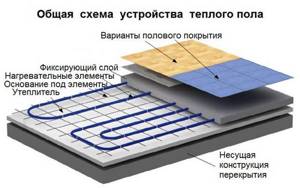
Before installing the “warm floor,” heat-insulating material is laid between the joists, on top of which a mesh is placed to secure the heating elements. In those places where the cable will pass through the logs, holes are cut into them and insulated with aluminum foil. After laying the heating cable, the finishing coating is installed.
If the heated floor in the heating system of a house with an attic is represented by a water circuit, for its operation it is necessary to install a boiler that will heat the coolant. In this case, polymer pipes can be used - they are able to withstand the temperature of the coolant, are convenient to install and have a long service life.
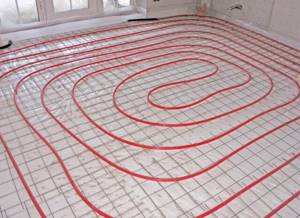
When the concrete is completely dry, a vapor barrier membrane and topcoat are placed on top of it. 20 days after pouring the concrete, you can perform a test run of hot water.
A water heated floor can be made in another way - by placing a metal plate with gutters for laying polymer pipes. In this case, the substrate and finishing coating can be laid directly on top of the plate without pouring a concrete screed on top of it. The heat coming from the hot water pipes is evenly distributed throughout the room. Typically this option is used as an auxiliary heat source.

